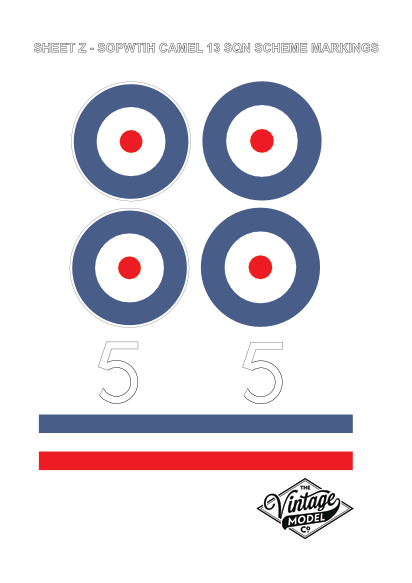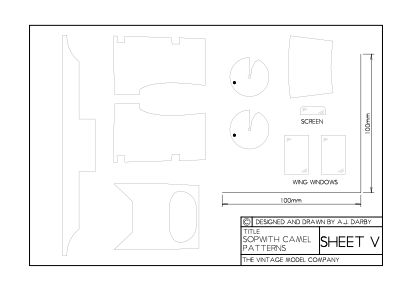SOPWITH F1 "CAMEL" - A FEARSOME FOE
Arguably the most famous and deadliest British aircraft of World War One, the Sopwith F1 Camel was designed by Herbert Smith as a replacement for his earlier design the Sopwith Pup. The Pup was being outclassed by German aircraft such as the Albatross DIII and a faster, more heavily armed replacement was required. The Pup was relatively easy to fly with somewhat benign characteristics, however the F1 was not.
The powerful Clerget rotary engine created powerful gyroscopic forces that coupled with the torque made the aircraft able to turn to the right very quickly but with a nose down tendency. These dynamic forces plus a nose heavy weight distribution made the aircraft manoeuvrable and a fearsome foe - but tricky to fly. This often ended in disaster especially for inexperienced pilots.
The F1 was the first British aircraft to have guns that fired through the propeller disc via a synchronising gear. These guns were mounted forward of the cockpit with the breeches housed in a "hump". This hump gave the F1 the unofficial nickname of "Camel", which became synonymous with the aircraft despite it never being an official designation.
Along with its stablemate the SE5A, the Sopwith Camel gave the RCF, RNAS and emerging RAF air superiority over the Luftstreitkrafte towards the end of the war.
YOUR KIT
This kit is designed for you to build a traditionally constructed, rubber powered, free flight model of a 1918 Sopwith F1 Camel of No.13 Squadron RNAS. The No. 13 Squadron RNAS (latterly 213 Squadron RAF) provided cover for naval sea planes and shipping, before supporting the Belgian army towards the end of the war.
This is a simple but striking scheme, but you can decide to do your own favourite or more complicated scheme if you wish as there are a vast number of Camel schemes to choose from. Construction of the model from this kit uses the traditional method of "stick and tissue", that consists of a built up balsa wood skeleton (framework), covered with a tissue skin. The balsa frameworks are built over a plan that is printed at the exact scale of the model, which is in essence a real engineering drawing. Power is provided by rubber strip motor that is wound up before flight.
Free flight means just that - once the model is launched, it is on its own. It must follow a predetermined flight path established when the model is initially adjusted for flight or "trimmed". This type of traditional building technique and flying requires a degree of patience and skill, but is extremely rewarding. Typically for a small model and in the spirit of the traditional kits, profiles are simplified and adjusted from the original and a relatively large propeller is used. This is done so that the model is light and stable enough to fly on its own, is simple in construction and can work with the rubber motor. These adjustments have been done with care and sensitivity so that the shape and spirit of the original aircraft is preserved as much as possible. Also in the spirit of the traditional kits, additional items required to build the model are things that can be found in the kitchen drawer or are easily available on the high street.
INCLUDED IN YOUR KIT
- Four balsa sheets with precise laser cut parts and strip wood.
- PVA glue for building the wooden frames.
- One 150mm diameter plastic propeller.
- One pre-bent motor hook and shaft.
- Small piece of thin acetate sheet for the upper wing window.
- Small piece of thick acetate sheet for the screen.
- Three low friction plastic "nose" bushings - one for the propeller and two for the undercarriage wheels.
- Piano wire for the main undercarriage legs.
- A matchstick for the tail skid.
- One motor peg (cocktail stick or toothpick).
- A plastic drinking straw (approximately 5mm in diameter).
- Rubber motor strip.
- Tissue to cover the model.
- Parts reference sheets (W), full size summary plan sheets (X), scheme diagram sheet (Y) and scheme markings (Z) printed on lightweight paper
Only Suitable For Ages 14+
Choking Hazard - Contains small parts, keep out of reach of children.
MARKINGS SHEETS
Here is the markings sheet included in your kit for you to download and print out at home.
Click on the image to download the file.

Here is an additional sheet of roundels provided for those builders who want to do their own Sopwith Camel and Triplane schemes that have roundels on the fuselage sides. The smaller roundels are for use on the Camel and the larger for the Triplane.
Generally, darker schemes used roundels with a white outline and lighter schemes, the roundels without a white outline.
Click on the image to download the file.
.png)
PATTERNS SHEET
Here is the patterns sheet included in your kit for you to download and print out at home.
Click on the image to download the file.

UK SHIPPING
Most orders are shipped via Royal Mail’s Tracked 48 service.
We are in a very rural location and so our Royal Mail collection is at around 1pm.
Example:
An order placed before 12pm on Monday should be with you on Wednesday.
An order placed after 12pm on Monday should be with you on Thursday.
For larger or heavier orders, we use APC to deliver your package on a Next Working Day service.
Example:
An order placed before 10am on Monday should be with you on Tuesday.
An order placed after 10am on Monday should be with you on Wednesday.
Shipping is free to UK Mainland addresses for orders over £30.00, otherwise we charge £6.00 for Royal Mail Tracked 48 parcels and £12.00 for APC Next Working Day.
NORTHERN IRELAND
Unfortunately, for the purposes of the new EU GPSR regulations introduced on 13th December 2024, Northern Ireland falls under EU jurisdiction.
Until we have worked out how to comply with the new rules, we will not send items to Northern Ireland.
We are really sorry about this and hope to have a solution in place early in 2025.
SCOTTISH HIGHLANDS & UK ISLANDS
Royal Mail considers the Scottish Highlands and UK Islands as part of the UK and so does not charge a premium for deliveries.
Pretty much all other UK couriers have surcharges for deliveries to the following postcodes: IV, HS, KA27-28, KW, PA20-49, PA60-78, PH17-26, PH30-44, PH49-50, ZE, IM, TR21-25
If you live in one of these postcodes and the parcel size of your order is outside Royal Mail's dimensions, you will have to pay a surcharge.
Our system is not clever enough to work this out and so if your order attracts a surcharge, we will contact you before despatch to see if you would like to pay the surcharge and proceed with the order or cancel and receive a full refund.
INTERNATIONAL SHIPPING
EU COUNTRIES
On 13th December 2024, the EU introduced new regulations with respect to product safety called GPSR.
There was very little publicity or notice given to small UK businesses about the new regulations, but needless to say, to comply will be time-consuming, onerous and probably expensive.
Unfortunately, until we have worked out how to comply with the new rules, we will not send items to EU countries.
We are really sorry about this and hope to have a solution in place early in 2025.
Smaller items
Items that fit within Royal Mail International Tracked Medium Parcel parameters (59cm x 17cm x 15cm weighing less than 2kg) can be sent to most countries outside the UK.
For example up to 3 of our smaller 18” wingspan kits can fit into one of these parcels.
A parcel like this currently costs around £18 to send to the USA and will take up to 3 weeks to arrive. This is because Royal Mail hands over the parcel to the local Post Office service for your country who have to clear it through customs and then deliver it to you.
The Royal Mail tracking code also transfers over to the tracking for your country’s postal service.
Larger items
For items that do not fit within Royal Mail International Tracked Medium Parcel parameters, we use standard international couriers such as DHL, FedEx and UPS.
These companies use something called volumetric weights to calculate the cost of shipping.
For example, a Balsa Basics RC bundle kit that measures 102cm x 34cm x 16cm and weighs 2.5 kg is actually calculated at 14kg!
This makes these very expensive to send outside the UK - a large kit can cost nearly £60 to send to the USA.